|
Motronic Fuel Maps
Motronic
fuel maps from a factory U.S. Carrera program optimized for
use with an oxygen sensor and catalytic converter.
The part throttle fuel map is mostly flat and designed to maintain a lean stiochiometric air/fuel ratio of 14.7:1
through the low and mid load regions to assist
the O2 sensor, for low emissions and good fuel economy
but not for power or throttle response. The upper rpm high load regions are set to go rich, countering the trim back adjustment of the O2 sensor.
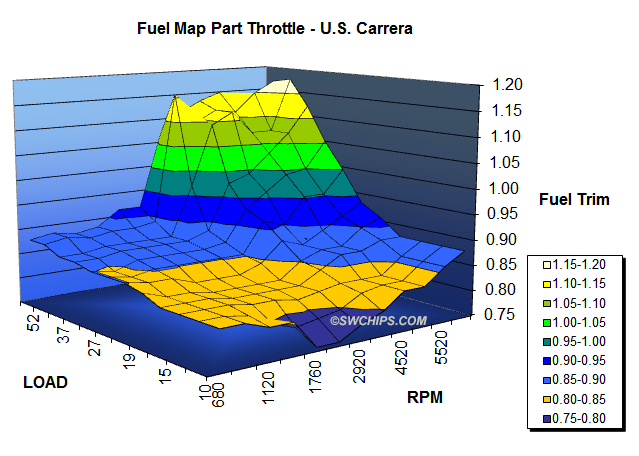
Fuel
maps from a factory European Carrera 3.2 without
O2 sensor and catalytic converter. The
part throttle fuel maps are richer under high part throttle loads
for increased torque and throttle response
over the U.S. cars.
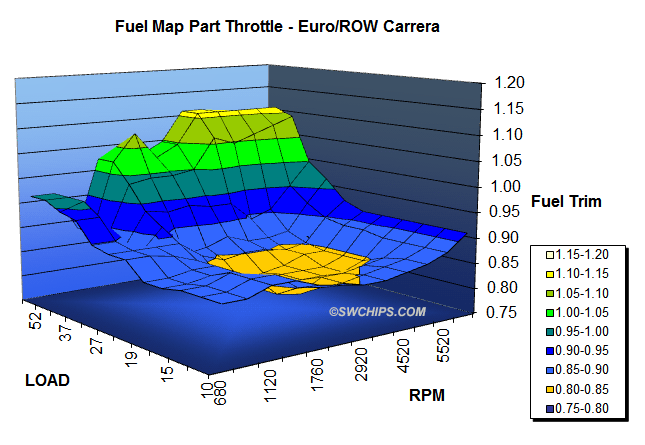
Performance
fuel maps are modified and remapped for maximum
performance and power. Reworking these regions bring
great benefits in overall power and drivability
because here is where the majority of drivers
spend at least 95% of the time. The low load region (<25%)
is kept virtually stock to maintain factory emissions
and fuel economy while cruising on the highway or
around town. For the O2 sensor equipped motors,
the sensor keeps the fuel mixture at a stoichiometric
14.7:1 for the best balance of fuel efficiency,
emissions and acceptable power. However, upon demand,
when maximum power is called for at higher engine
loads such as during acceleration, the max power
air/fuel ratio of 12.8-13.0:1 is delivered on demand for maximum
throttle response, torque, and horsepower. This
produces the best balance of fuel efficiency and
emissions, while delivering maximum power on demand.
Our chips idle cleanly without an overly rich mixture.
You won't have a lean spot from 1200 to 2000 rpm
causing off idle bog, and most importantly avoid
the dangerously lean tendency at high rpms under
full loads.
The
following chart displays the differences in the factory
full throttle fuel mapping between a U.S. spec catalytic converter equipped motor,
and a European/ROW
spec motor with a premuffler instead of
a catalytic converter. Because full throttle is
where most drivers are at less than 5% of the time,
the full throttle fuel map should be optimized for full
power and not for emissions. However, because of the more restrictive cat, and in the interest of low emissions, U.S. chips are programmed leaner below 4000 rpm than their ROW counterparts to maintain the emissions friendly stoichiometric ratio. Reoptimizing this region often brings increases of 6-10 ft-lbs of torque. After 5200 rpm though, the U.S. curve is excessively
rich as the excess fuel helps to keep the ceramic monoliths of the catalytic converter cool under hours of sustained wide open throttle operation near redline on the Autobahn. As most owners do not drive nonstop for hours at 150 mph with a catalyst, optimizing the air fuel ratio in this region especially with stock motors, increases the total hp under the curve significantly, with typical gains of 16 hp at 6000, increasing to 25-35 hp in the 6400 rpm zone.
Full
throttle is signaled to the DME by the activation
of the full throttle microswitch at the throttle
butterfly. At full throttle most input sensors are
ignored, including the O2 sensor. The DME thus references
the full throttle fuel map that has been preprogrammed
for the stock setup. This means that no matter what
modifications one performs to a motor, including
exhaust modifications and displacement increases, no additional fuel will be
injected and horsepower increases will be limited.
When engine modifications increase airflow into
the engine, such as by sport exhausts and intake
modifications, it thus becomes necessary to reprogram
the amount of fuel injected to maintain the optimum
air/fuel ratio. If this is ignored, the danger exists
of an excessively lean running engine at full load,
leading to increasing combustion chamber temperatures,
and thus the risk of engine damage by predetonation.
Adjusting
the DME to meet new boundary conditions such as
those presented by sport mufflers, European premufflers or cat bypasses,
headers, high flow catalytic converters, and higher octane
fuels will in such instances open new potential
for increased power gains by optimization.
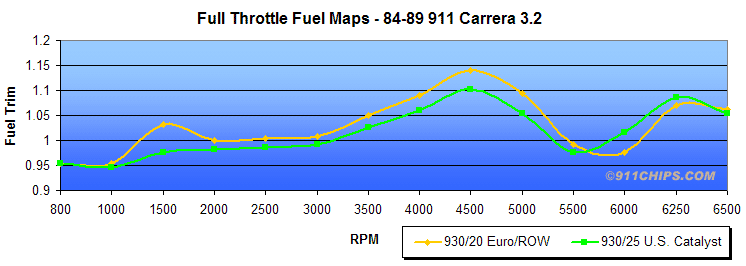
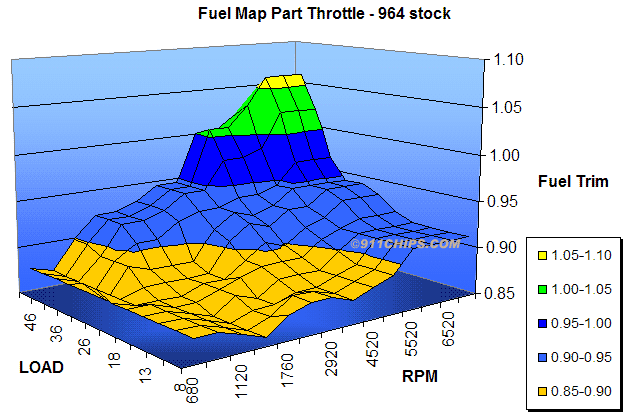
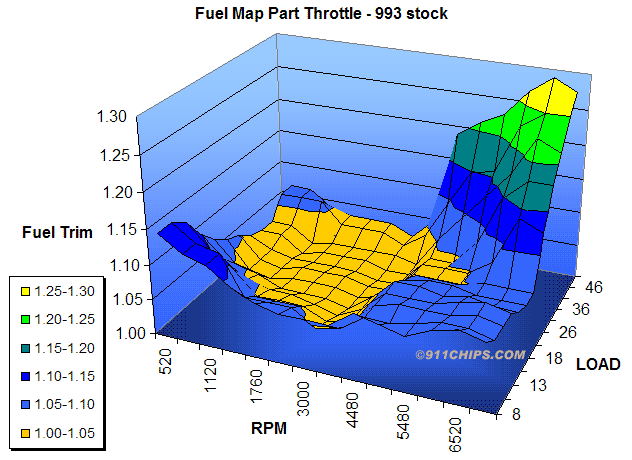
|
